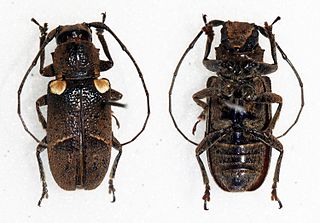Dunn's gerbil is a rodent species distributed mainly in Eritrea, Ethiopia, Somaliland and Djibouti. It is an animal of dry grassland and rocky plains. It is also sometimes called the "Somalia gerbil", not to be confused with the Somalian gerbil or the Somali gerbil.

Dunn's lark is a small passerine bird of the lark family. It is a desert bird which is found across parts of the Sahara from Mauritania to central Sudan.
Caecilia dunni is a species of caecilian in the family Caeciliidae. It is endemic to Ecuador and known from the Amazon basin in Napo and Pastaza Provinces. The specific name dunni honors Emmett Reid Dunn, a prominent American herpetologist. Common name Dunn's caecilian has been coined for it.
"Prostherapis" dunni is a species of frog endemic to the Venezuelan Coastal Range. Its taxonomic position is uncertain, apart from its placement in the family Aromobatidae; it might be an Aromobates.

The Oita salamander is a species of salamander in the family Hynobiidae endemic to Japan. Named after Oita Prefecture, its natural habitats are temperate forests, rivers, intermittent rivers, freshwater marshes, intermittent freshwater marshes, and irrigated land in western Japan. It is threatened by habitat loss, due to the increasing construction of homes within its habitat. The Oita Salamander is considered to be vulnerable by the (IUCN) Red List of Threatened Species with a declining population.
Dunn's climbing salamander is a species of salamander in the family Plethodontidae. It is found in Guatemala and Honduras. Its natural habitat is subtropical or tropical moist montane forests. It is threatened by habitat loss.

Dunn's salamander is a species of salamander in the family Plethodontidae endemic to the western United States.
The Patzcuaro frog is a species of frog in the family Ranidae. Within the former, broadly defined genus Rana, it belongs to the Rana montezumae subgroup of the Rana pipiens complex. It is endemic to the Michoacán state, Mexico, where it is locally known as rana de Pátzcuaro. It occurs in Lake Pátzcuaro, Lake Cuitzeo, and the surrounding streams in Río de Morelia.

Ammomanes is a genus of lark in the family Alaudidae.
Dunn's mud turtle, also known commonly as the Colombian mud turtle, is a species of turtle in the family Kinosternidae.

Porthidium dunni is a species of venomous pitviper in the family Viperidae. The species is endemic to Mexico. There are no recognized subspecies.
Emmett Reid Dunn was an American herpetologist noted for his work in Panama and for studies of salamanders in the Eastern United States.

Tropidostoma is a medium-sized herbivorous oudenodontid dicynodont therapsid that lived during the Late Permian (Lopingian) period in South Africa. The first Tropidostoma fossil was described by Harry Govier Seeley in 1889. Later two subspecies were identified. Tropidostoma fossils are an index fossil in a biozone of the Karoo Basin known as the Tropidostoma Assemblage Zone. This biozone is characterized by the presence of this species in association with another dicynodont species, Endothiodon uniseries.
Lepidochrysops dunni, the Boorman's giant Cupid, is a butterfly in the family Lycaenidae. It is found in Nigeria. The habitat consists of Guinea savanna.

Cimoliopterus is a genus of pterosaur that lived during the Late Cretaceous in what is now England and the United States. The first known specimen, consisting of the front part of a snout including part of a crest, was discovered in the Grey Chalk Subgroup of Kent, England, and described as the new species Pterodactylus cuvieri in 1851. The specific name cuvieri honours the palaeontologist George Cuvier, whereas the genus Pterodactylus was then used for many pterosaur species that are not thought to be closely related today. It was one of the first pterosaurs to be depicted as models in Crystal Palace Park in the 1850s. The species was subsequently assigned to various other genera, including Ornithocheirus and Anhanguera. In 2013, the species was moved to a new genus, as Cimoliopterus cuvieri; the generic name Cimoliopterus is derived from the Greek words for "chalk" and "wing". Other specimens and species have also been assigned to or synonymised with the species with various levels of certainty. In 2015, a snout discovered in the Britton Formation of Texas, US, was named as a new species in the genus, C. dunni; the specific name honours its collector, Brent Dunn.

Prosoplus is a genus of longhorn beetles of the subfamily Lamiinae, containing the following species:

The Wedding Party is a 2016 Nigerian romantic comedy drama directed by Kemi Adetiba. It premiered on 8 September 2016 at the Toronto International Film Festival in Canada and on 26 November 2016 at Eko Hotel and Suites in Lagos. The film was released worldwide on 16 December 2016, and became the highest grossing Nigerian film; a record which was broken in 2017 by its sequel The Wedding Party 2.

Geophis dunni is a species of enigmatic snake in the family Colubridae. The species is presumably endemic to Nicaragua and is only known from a single specimen discovered in 1932. This specimen, the holotype, was discovered by Karl Patterson Schmidt in the stomach of a Central American coral snake, and no additional specimen has been seen since. The holotype has a snout-to-vent length (SVL) of 310 mm (12 in), a tail length of 57 mm (2.2 in), and a total length of 367 mm (14.4 in). It is part of the Geophis sieboldi species group according to Floyd Leslie Downs. This species was named by Schmidt after fellow herpetologist Emmett Reid Dunn "in allusion to his important contributions to our knowledge of this group of snakes".
Dunn's least gecko is a species of lizard in the family Sphaerodactylidae. The species is endemic to Honduras.
Anolis dunni, also known commonly as Dunn's anole and abaniquillo de Dunn in Mexican Spanish, is a species of lizard in the family Dactyloidae. The species is native to southern Mexico.









